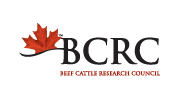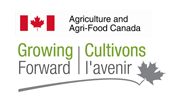Fishing for Efficiency
| Project Code: | FDE.05.09 |
| Completed: | April 2011 |
Project Title:
Whole Genome Scan for Feed Efficiency
Researchers:
Dr. Stephen Moore
Stephen Moore, Ph.D. (University of Queensland; formerly University of Alberta), Steve Miller, Ph.D., Ira Mandell, Ph.D., Kendall Swanson, Ph.D. (University of Guelph), Graham Plastow, Ph.D., Zhiquan Wang, Ph.D., Paul Stothard, Ph.D., Changxi Li, Ph.D., John Basarab, Ph.D. (University of Alberta), and Tim McAllister, Ph.D. (AAFC Lethbridge)
Background The purchase price of a calf and the expense of the feed needed to finish it are the two largest variable costs facing the cattle feeding sector. Therefore, feed efficiency is economically critical in the beef industry. Feed efficiency is a heritable trait, so it will respond to genetic selection. Currently, identifying breeding stock that are more feed efficient than average is very difficult and expensive because it requires specialized equipment and measurements of feed intake on individual cattle.
Recent advances in DNA technology may eventually provide a solution to this problem. The entire DNA sequence of cattle was recently mapped and published in 2009. This effort revealed thousands of sites in the DNA sequence that vary from one animal to another. These small variations in the DNA sequence are called single nucleotide polymorphisms (SNPs). Because the DNA sequence is the animal’s genetic blueprint, some of these SNP’s may be located in genes related to feed efficiency (and other economically important traits). If so, they may allow DNA-based diagnostic tests to be developed. A DNA test that reliably detects differences in efficiency may allow the identification and selection of superior breeding stock more economically and earlier in life than current methods.
Objectives The objective of this study was to identify and validate DNA markers for feed efficiency by screening a large population of cattle with feed efficiency records against more than 50,000 different SNP markers.
What they did Three different populations of cattle were used for the initial marker discovery and validation steps. These were crossbred cattle (827 head) from the University of Guelph breeding program, purebred Angus and Charolais (938 head) from the Canada-Alberta Livestock Research Trust herd, and a synthetic beef strain (852 head) at the University of Alberta’s Ranch at Kinsella, Alberta.
All of these cattle had individual feed intake records. Within each population, cattle were screened against the 50,000 markers on the DNA panel to identify the SNP markers that were significantly associated with feed efficiency in each of the three populations. The researchers then examined whether the same markers worked similarly in the two other populations.
Because the DNA sequence of cattle is known, the researchers were also able to divide the SNP markers into 1,095 groups called haplotypes, each containing a string of 49 linked SNP’s. Each animal’s haplotypes were compared to its actual feed efficiency to find which of the haplotypes were the most highly associated with feed efficiency. Combinations of haplotypes that were associated with differences in feed efficiency were also identified.
Finally, equations were developed to predict an animal’s feed efficiency based on the SNP genotypes, haplotypes, and combination of haplotypes. The prediction accuracy of these equations was first tested within the populations that were used for the marker discovery by comparing predicted feed efficiency (based on DNA markers and haplotypes) to actual feed efficiency (based on intake records). The prediction accuracy of the equations was also validated on a fourth population of cattle with feed intake data that were unrelated to the three discovery populations (839 crossbred and synthetic cattle from research, breeding and commercial herds).
What they learned Between 22 and 28 individual SNP markers were found to be very highly significantly associated with feed efficiency in each of the three discovery populations. However, the markers that were related to feed intake were different in all three populations. None of the individual markers overlapped across all three populations.
For each population, approximately 70 haplotypes were discovered that could explain 37% of the variation in feed intake, and these different haplotypes fell into 5 different groups with similar haplotype patterns.
During the initial validation step, the equations based on the DNA markers and haplotypes explained between 10 and 22% of the variation in actual feed efficiency. This may have been higher if more animals with feed intake data had been used to develop the DNA-based prediction models. It also indicates that feed efficiency is influenced by many different genes, each with a very small effect. Not surprisingly, the prediction accuracy of these equations was even lower (by 69%) when they were tested on the fourth, entirely independent validation population.
What it means Feed efficiency is a very complex trait, with many genes involved. This makes it difficult to develop reliable DNA tests. More research is needed before DNA tests for feed efficiency are consistent and reliable enough to be adopted by the seedstock or commercial beef sectors.








